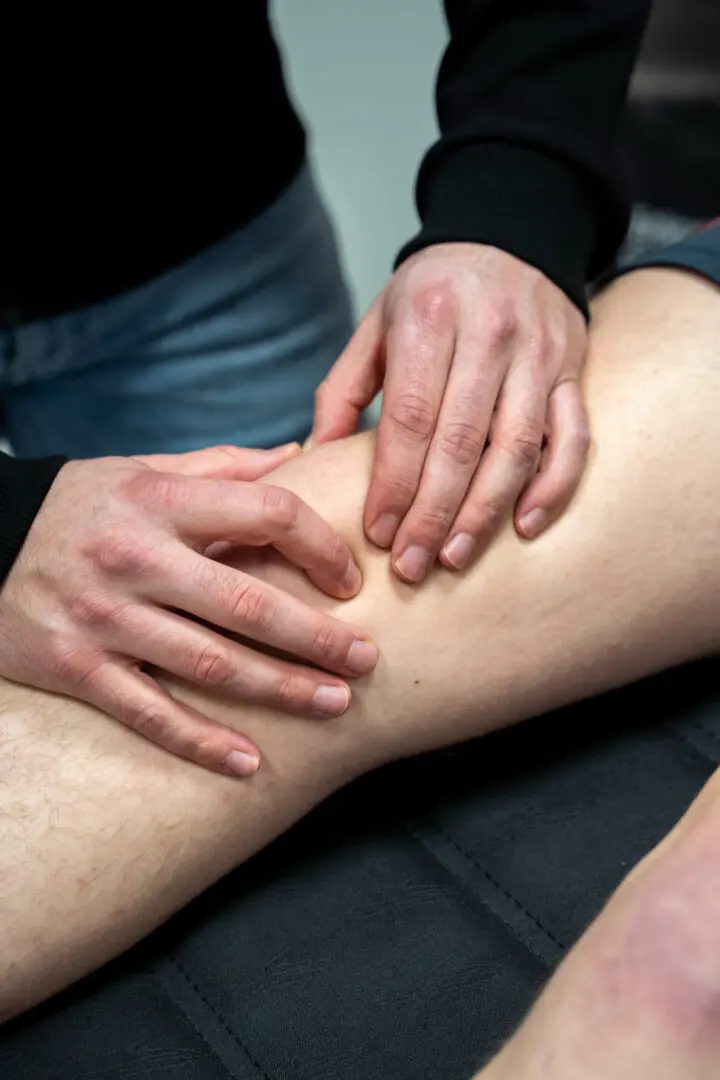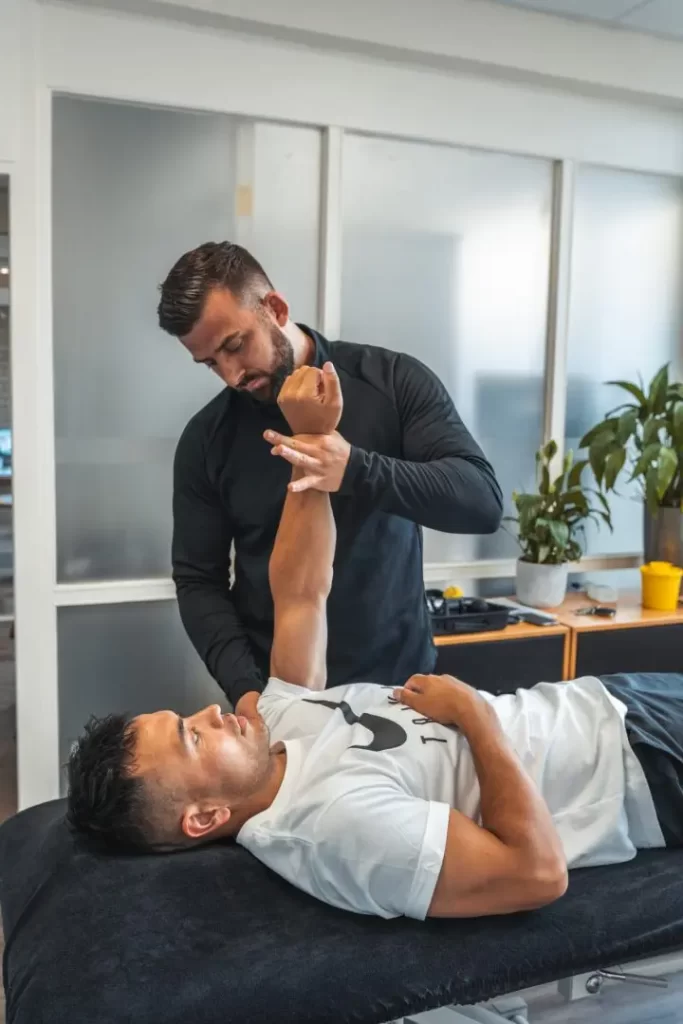Jumpers knee
A jumpers knee involves pain at the front of the knee. It is a complaint particularly common among athletes, and as the name suggests, especially sports that involve a lot of jumping. Jumpers knee is therefore common in sports such as handball, basketball and volleyball, but also in other sports where explosive jumping is common. Recovering from a jumpers knee can take a long time without proper guidance from a physiotherapist.
The knee consists of several bone pieces, namely the thigh bone (femur), the kneecap (patella) and the shin bone (tibia). In a jumpers knee, the tendon running from the kneecap to the tibia is irritated. This irritation is caused by repeated large pulling forces often demanded in sports. This is due to the frequent braking and acceleration of movement that recurs in these sports. Often, we see the symptoms arise because the tendon does not get around to recovering sufficiently after strain and, as a result, the strain capacity of the tendon decreases. We also actually see changes in the structure of the tendon over time. The quality of the tissue decreases. We regularly hear people say that the affected area is swollen, and this can be true. In fact, we know from research that the tendon will still try to repair itself and create extra cells for this purpose. As a result, we then actually get a thicker tendon (more on this later).

Causes Jumpers knee
Besides knowing which athletes may be at risk of jumpers knee, we also see that it is an injury more common in men than in women. Furthermore, the injury is also seen more often in young adults and adults. Risk factors for developing a jumpers knee are:
- Increase in (sports) load
- Overweight
- Reduced flexibility of other surrounding muscles (calf muscles, hamstrings, quadriceps)
- Foot abnormalities
- Practising sport at a high level
Did you know that 50% of professional volleyball players suffer from jumpers knee at times? En that this percentage is 32% of professional basketball players? In amateur sports, the percentages are fortunately a bit lower. Here we see 14% of volleyball players.
A tendinopathy/tendon problem often develops gradually and increases in severity over time. The course of symptoms is often recognisable and goes as follows:
- Complaints at the start of an activity that gradually disappear. This is followed by an after-reaction when the activity is over.
- Complaints at start of activity that gradually disappear
- Complaints that do not disappear during activity.
- Complaints present even at rest.
Risk factors
Risk factors
Complaints and symptoms
A jumpers knee is characterised by pain to the knee below the kneecap. In addition, symptoms may present as:
- Morning stiffness
- Pain related to (sports) strain
- Being able to exercise less
- Gradual onset of symptoms
- Thickening of the tendon.
When and how long the pain symptoms occur depends on degree of irritation of the tendon and the activities you undertake. In some cases, the symptoms are limited to playing sports, while others also experience pain during daily activities.
Diagnosis and examination Jumpers knee
The diagnosis in a jumpers knee is made by the story the patient tells during the intake that fits a jumpers knee. The physiotherapist can then perform tests to confirm whether a jumpers knee is indeed present. For this, we use performing a one-legged squat on incline. The physiotherapists at Fysio Fitaal Tilburg are well able to map out your symptoms. In addition, we have the ability to perform an ultrasound of the tendon to identify abnormalities in the tendon structure. Other imaging examination is not advised, as it does not give us any additional insights in this type of complaint.
Jumpers knee treatments
Treatment of a jumpers knee consists of several stages and components. First, it is often necessary to adjust the sports load. A temporary adjustment is simply necessary to give tissue time to recover. Fortunately, adapting does not mean stopping your sport. In fact, mild complaints may be felt during activities. In practice, we see that the extent to which you can play sports in the first phase varies a lot from person to person. You can often do other activities such as walking and cycling. You can always discuss with your physiotherapist what is convenient to do.
Next, it is important to start determining what may have caused the symptoms. Has there been any change in the intensity (jump load, sprint load), frequency or duration of training. In addition, it is useful to ask yourself whether there has been a change in factors such as your surface or footwear. These are all factors that can be influenced well to increase the chances of recovery but also reduce the chances of the injury returning.
Then you get to work on train. something that is badly needed to stimulate the newly formed cells in the tendon (which we talked about earlier) to create new tendon tissue and structure it in the tendon's tensile direction. To do this, we use a training structure that research has shown works very well to reduce tendon pain. The training builds up from isometric load to isometric load (building up in load) and finally plyometric training (jumping and running forms) and sports-specific exercises. You can map out this entire route together with your physiotherapist.
During your 'rehabilitation process', it is okay to feel some pain. Scoring this from 0 (no pain) to 10 (extreme pain), we want pain to score no higher than a 3-4. This applies both during activities and to the reaction in the 24 hours afterwards. If you do notice that pain scores higher than a 3 or 4, you will have to adjust the load and postpone your next workout for a while until you get back to your starting point.
Fortunately, the prognosis of jumpers knee is good. We see that at least 80% of those who adhere well to his/her rehabilitation plan experience a sharp decrease in symptoms within about six months. Full recovery can take months to years and be variable over time. Besides exercise therapy and load adjustment, many other treatment methods are also offered.
Shockwave
Shockwave is a form of therapy that has gained a lot of popularity in recent years. However, there is little scientific evidence for its efficacy. In the case of jumpers knee, research shows that it seems to have little to no positive effect on symptoms and recovery. It is therefore not recommended to use shockwave therapy for these complaints.
Dry needling
Dry needling is well known to many by now. A form of therapy in which thin needles are pricked through the skin into painful tissue. Many thoughts on the possible effects of dry needling have already been expressed in the field. Research has shown that dry needling can help reduce pain in a jumpers knee. This, however, in combination with a correctly designed exercise programme. We know that reducing pain does not necessarily mean improving the function and quality of the tendon. This is what you work on with the exercise programme.
Injections
Sometimes injection is suggested if recovery just won't happen. We think it is important to carefully consider the pros and cons of this treatment. You will consult your GP (or rather orthopaedist) for this treatment. It is known that injections with corticosteroids can have a good short-term pain-relieving effect, but do negatively affect the quality of the tissue in the long term. It is for this reason that using this type of treatment is only advised if recovery after a long period of exercise therapy really won't work.
Related complaints

Knee complaints
Especially with knee problems, it is imperative to get a good picture of the...
Making an appointment at FysioFitaal
We work from multiple locations in Tilburg, always close by for professional and accessible physiotherapy. Fill in the contact form and we will contact you soon. Together, we will work on your recovery!

